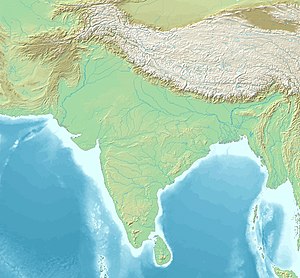Battle of Mandalgarh
| Battle of Mandalgarh | |||||||
|---|---|---|---|---|---|---|---|
| Part of Mewar-Malwa Conflict | |||||||
| |||||||
| Belligerents | |||||||
|
Vassal states: | Malwa Sultanate | ||||||
| Commanders and leaders | |||||||
|
|
| ||||||
Mandalgarh: Battlefield location | |||||||
The Battle of Mandalgarh took place in 1473. Following an earlier unsuccessful attempt by Ghiyath Shah (Ghiyas-ud-Din, r. 1469–1500), the Sultan of Malwa, to capture Chittorgarh from the Kingdom of Mewar, Zafir Khan, one of Ghiyath Shah's generals, led a force which raided and plundered Mewar. In response, a combined force of Rajput armies, assembled by the Maharana of Mewar, met Zafir's army at Mandalgarh; here too, the Malwa forces met with a crushing defeat.
Prelude
[edit]This section is empty. You can help by adding to it. (January 2024) |
Outcome
[edit]Early in the reign of Rana Raimal of Mewar (r. 1473–1509), a general of the Sultan of Malwa's army, Zafar Khan, marched into Mewar at the head of a large force. The armed incursions may have been at the behest of his sultan, Ghiyath Shah, who remained in his capital at Mandu, or possibly Zafir embarked on his raiding on his own initiative. In either case, a desire to redress the earlier severe defeat of Malwar forces under their sultan, Ghiyath Shah, was likely the instigating factor in the raids. During his campaign, Zafir captured Kotah, Bhainsror and Sheopur, installing his own local thanadars (administrators). The countryside in the vicinity was plundered and laid waste.[4]
Upon hearing of the Malwar incursions, Rana Raimal called his chiefs, including the governors of Amber, Chanderi and Raisen, to march with him against Zafar Khan. The opposing forces met and clashed at Mandalgarh, where Zafar Khan was soundly routed by the combined Rajput force, losing many of his commanders in the battle. Rana Raimal pursued Zafar in his retreat to Mandu,[1][4] catching up with him at Khairabad (near Kotah) where the opposing armies fought again. The Rajputs sacked the town and extracted heavy fines from the Sultan of Malwa.[2][5]
See also
[edit]References
[edit]Citations
[edit]- ^ a b Somani (1976), p. 148.
- ^ a b Sarda (1918), p. 7.
- ^ Mankekar (1976), p. 32.
- ^ a b Day (1965), p. 225.
- ^ Munshi (1960), p. 339.
Works cited
[edit]- Day, Upendra Nath (1965). "Chapter IX: Reign of Ghiyath Shah (A Period of Peace and Plenty)". Medieval Malwa: A Political and Cultural History 1401–1562 (First ed.). Delhi: Munshi Ram Manohar Lal. pp. 220–248.
- Mankekar, D. R. (1976). Mewar Saga: The Sisodias' Role in Indian History. Vikas Publishing House. ISBN 978-0-7069-0416-1.
- Munshi, K. M. (1960). History and Culture of the Indian People. Vol. 6. Delhi Sultanate. Bharatiya Vidya Bhavan.
- Sarda, Har Bilas (1918). Maharana Sanga: The Hindupat, the last great leader of the Rajput race. Ajmer: Scottish Mission Industries.
- Somani, Ram Vallabh (1976). History of Mewar: From earliest times to 1751 A.D. Jaipur: C.L. Ranka. OCLC 292985.

